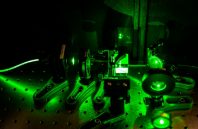A new way of measuring atomic-scale magnetic fields with great precision, not only up and down but sideways as well, has been developed by researchers at MIT. The new tool could be useful in applications as diverse as mapping the electrical impulses inside a firing neuron, characterizing new magnetic materials, and probing exotic quantum physical phenomena.
The new approach is described today in the journal Physical Review Letters in a paper by graduate student Yi-Xiang Liu, former graduate student Ashok Ajoy, and professor of nuclear science and engineering Paola Cappellaro.
The technique builds on a platform already developed to probe magnetic fields with high precision, using tiny defects in diamond called nitrogen-vacancy (NV) centers. These defects consist of two adjacent places in the diamond’s orderly lattice of carbon atoms where carbon atoms are missing; one of them is replaced by a nitrogen atom, and the other is left empty. This leaves missing bonds in the structure, with electrons that are extremely sensitive to tiny variations in their environment, be they electrical, magnetic, or light-based.

 (585) 768-2513
(585) 768-2513

